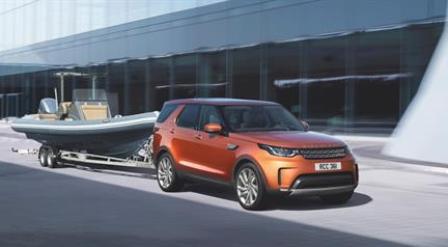[dropcap]F[/dropcap]rom hitching-up and hitting the highways of the UK and Europe to parking at the campsite, Daniel Rogers, towing expert at Land Rover, shares invaluable advice for drivers building confidence when towing.
TOP TIP 1: Preparation and Packing

Even ahead of setting off, you can pack your belongings to reduce the risk of your trailer or caravan weaving, yawing and snaking by loading the trailer or caravan in a specific way that distributes weight efficiently.
The centre of gravity of the load needs to be about 10-20 cm in front of the trailer or caravan’s wheels, which can be achieved by loading slightly more weight in the front half of the trailer or caravan than in the rear, ensuring that you don’t exceed the recommended towing weight for your vehicle, of course.
You should never load a trailer so that it is lower at the rear. It should be either level, or ideally, slightly nose down. Any load should be secured to the trailer tie-downs where available and you’re good to go.
Remember it is a legal requirement to use extended mirrors when towing. This ensures you have full visibility around the vehicle for safety purposes.
TOP TIP 2: On the road
The key thing to remember when driving with a trailer or caravan, is that you need to allow more time and room for everything. Make sure you allow a gap of at least four seconds to the vehicle in front, anticipate junctions and stops to allow you time to brake early and allow extra room for turning and manoeuvring.
Whenever you start your journey, take time to test the brakes when it is safe and considerate to do so, to understand how that particular load will affect stopping when required.
If when driving with a trailer or caravan you experience weaving [moving from side to side], there are a few simple solutions to resolve the problem:
- Adjust the trailer contents to move the centre of gravity forward (see Top Tip #1)
- Avoid over-packing the trailer and ensure the maximum trailer weight is not exceeded
- Increase the trailer and vehicle tyre pressures according to the manufacturer’s specification
- Fit a ‘hitch yaw damper’ to reduce the side-to-side movement
- Reduce driving speed
TOP TIP 3: Parking
Reversing with a trailer or caravan is a gentle, slow and steady art. You should start reversing with the vehicle and trailer in a straight line, before slowly turning the vehicle in the opposite direction to the one in which you wish the trailer to travel. Do not continue too far as the vehicle and trailer may ‘jack-knife’. Once the trailer is moving in the correct direction, reverse the steering of the vehicle and follow the trailer into the turn, straightening up when you reach the correct direction.
Daniel, said: “It is vital that no matter how often you tow a trailer, you take the time to prepare properly and don’t rush your journey. There is a lot to get used to and many problems which can easily arise. Even with the wide range of technology available – such as our Advanced Tow Assist system which allows you to park your trailer without even touching the steering wheel – it is still vital that anyone looking to tow has a good understanding of the physics and theory behind it. We hope these three tips help those heading camping this bank holiday weekend tune-up their towing skills and reduce the risk of incident.”




